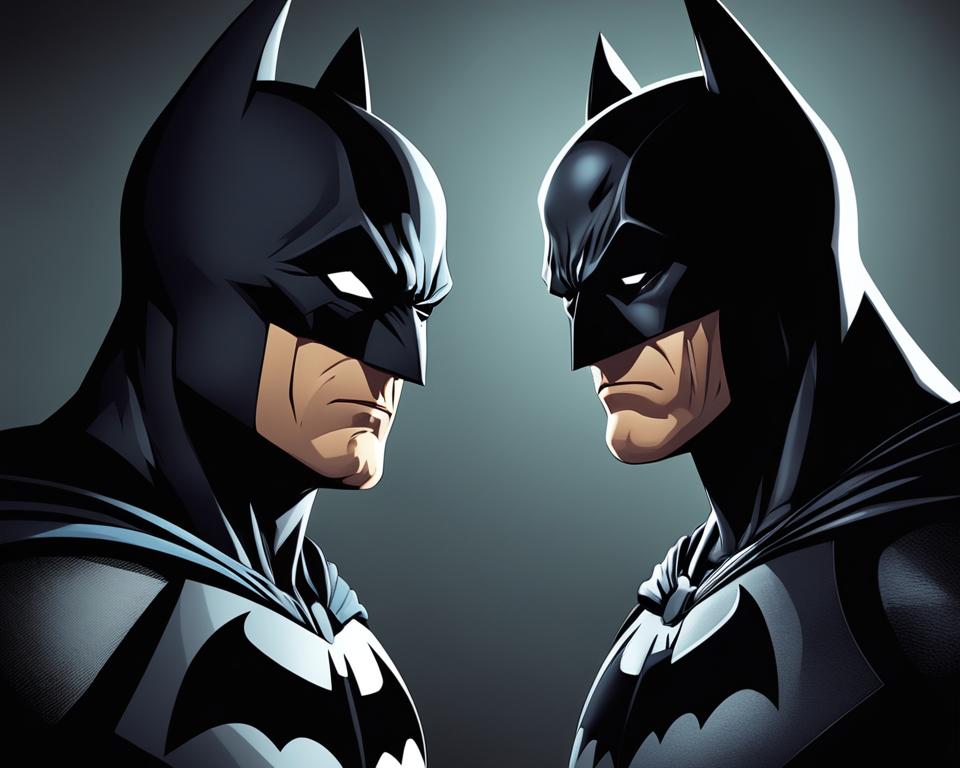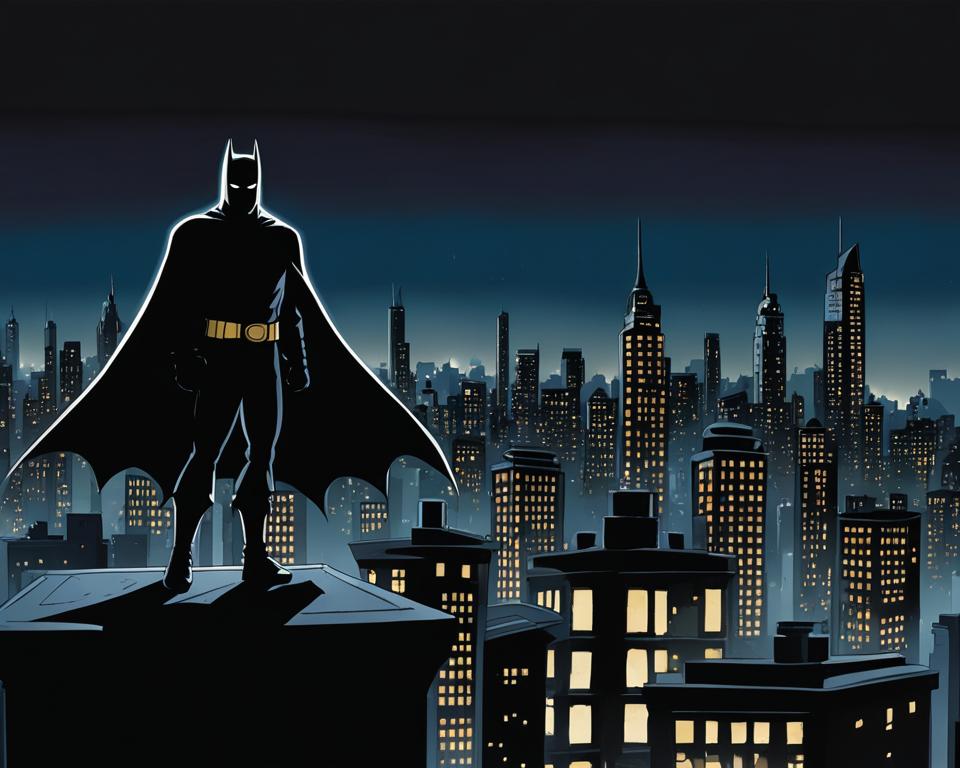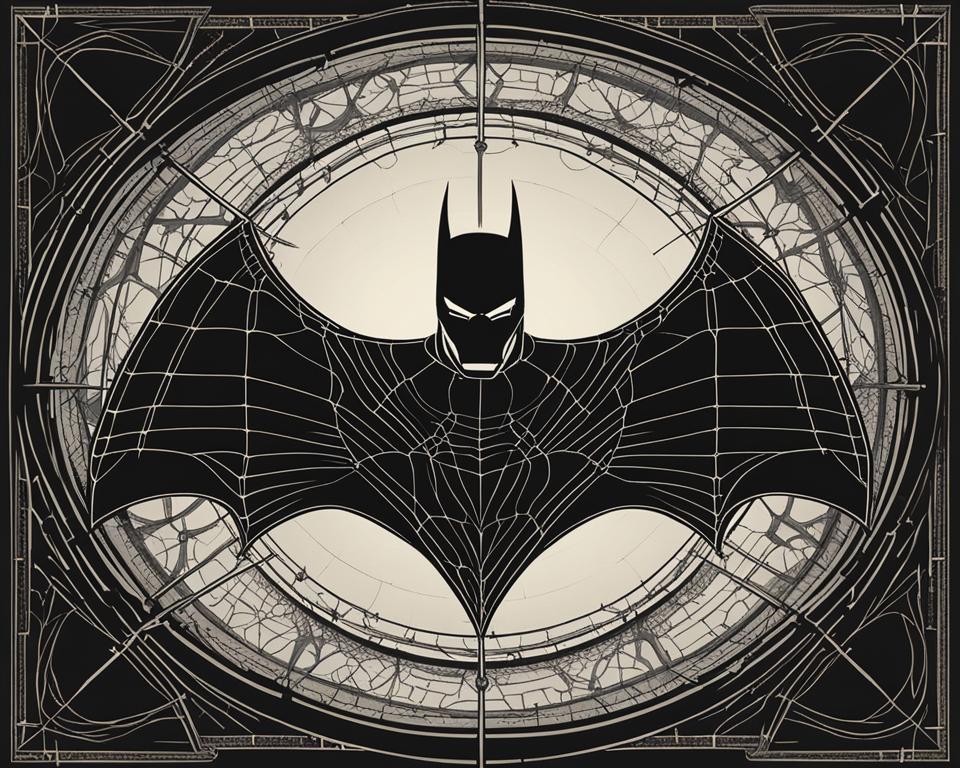
Welcome to a comprehensive analysis of one of the most beloved superheroes of all time: Batman. In this article, we delve deep into the intriguing character of Batman and uncover the reasons behind his enduring popularity. From his fascinating history to the psychological profile that drives him, we unveil the many layers of the Dark Knight.
Why is Batman so popular? That’s a question we aim to answer by exploring the rich mythology and symbolism behind the Caped Crusader. But first, let’s take a quick look at the history of the Dark Knight. Created by artist Bob Kane, Batman made his first appearance in Detective Comics #27 in 1939. Since then, he has captured the hearts and imaginations of millions around the world.
Now, join us on a journey where we analyze Batman’s sociological perspective, his psychological profile, his iconic gadgets, and his rogues gallery of villains. We’ll also dive into the symbolism of his logo, his origin story, and the moral code that sets him apart from other superheroes. With each section, we’ll uncover the various elements that make Batman a cultural icon and explain why his legacy endures.
So, buckle up and prepare to venture into the dark and captivating world of Batman: The Dark Knight!
Sociological Perspective in Batman: The Dark Knight
In Batman: The Dark Knight, director Christopher Nolan provides a captivating sociological perspective that sheds light on the social and economic inequality prevalent in Gotham City. The film explores the dynamics between the wealthy elites, represented by the enigmatic Bruce Wayne, and the common criminals who struggle to survive in a city plagued by disparity.
The stark contrast between the affluent and the impoverished is highlighted throughout the movie, emphasizing the degree of class segregation that exists within Gotham. The wealthy elites, including Wayne, possess immense power, resources, and influence, which they use to maintain control over the city and its inhabitants.
“In their relentless pursuit of self-interest, the wealthy elites perpetuate social and economic disparities, creating a divide between themselves and the less fortunate, who are left to fend for themselves in a corrupt and decaying society.”
This exploration of class segregation aligns with the sociological concept of functionalism, which recognizes the interdependence of social structures and their impact on individuals and groups. The movie delves into the functioning of Gotham City, showcasing how the actions of the wealthy elites affect the lives of those in lower socio-economic positions.
Deviance is another sociological theme explored in Batman: The Dark Knight. The movie introduces the Joker, a symbol of chaos and an agent of disruption in the established order. Through the Joker’s actions, the film examines the moral boundaries of society and the response of individuals faced with deviant behavior.
The sociological perspective presented in Batman: The Dark Knight raises important questions about the nature of power, morality, and the role of the wealthy elites in perpetuating social and economic inequality. By examining the societal dynamics within Gotham City, the film prompts viewers to reflect on the real-world implications of class segregation and the impact of the choices made by those in positions of privilege.
Through its exploration of sociological concepts such as social and economic inequality, wealthy elites, functionalism, deviance, and class segregation, Batman: The Dark Knight offers a thought-provoking and introspective analysis of contemporary society. The film challenges audiences to consider the consequences of unchecked power, the complexities of morality, and the potential for change in a world grappling with social and economic disparities.
Psychological Profile of Batman

The character of Batman is a fascinating study in psychology, shaped by the alter ego of Bruce Wayne. Batman’s journey as a crime-fighter is rooted in childhood trauma and the fear that accompanies it.
As a child, Bruce Wayne experienced the tragic loss of his parents, witnessing their murder before his own eyes. This traumatic event left an indelible mark on his psyche and instilled in him a deep sense of justice.
The fear that Bruce felt during that pivotal moment in his life became a driving force behind his alter ego, Batman. He channels that fear into unwavering determination, using it to confront and overcome the criminals who plague Gotham City.
Deep down, Bruce Wayne’s desire to protect Gotham and bring justice to its streets is not only fueled by his traumatic past, but also by his internal struggles. Batman embodies the complex nature of the human psyche, wrestling with his own fears and demons while fighting for what he believes is right.
Understanding the psychological makeup of Batman is key to comprehending his motivations and actions. It sheds light on the depths of his character and the inner turmoil he grapples with as he seeks to make Gotham a safer place.
“It’s not who I am underneath, but what I do that defines me.” – Bruce Wayne
Bruce Wayne: A Facade of Wealth and Privilege
Bruce Wayne’s alter ego serves as a facade, masking the psychological scars he carries from his childhood trauma. By day, he presents himself as a wealthy socialite, a member of Gotham City’s elite. This persona allows him to navigate the upper echelons of society, gathering information and resources to fuel his crime-fighting endeavors as Batman.
However, beneath the veneer of wealth and privilege lies a man haunted by his past, driven by a deep-seated need for justice and redemption. The psychological complexities of Bruce Wayne give depth and nuance to his character, making him relatable to audiences who recognize the duality of human nature.
The Role of Fear in Batman’s Quest for Justice
Fear is a central theme in Batman’s character development. It is the source of both his power and vulnerability. By embracing and utilizing his own fear, Batman strikes fear into the hearts of criminals, becoming an embodiment of their worst nightmares.
However, Batman’s fear is not limited to his enemies. It is a constant companion, a reminder of his own limitations and the fragility of the human psyche. Batman’s relentless pursuit of justice is his way of reclaiming power over his fears and protecting Gotham City from the chaos that once consumed him.
The Drive for Justice
Batman’s unwavering commitment to justice stems from a strong moral compass. He believes in the inherent goodness of humanity and fights to protect the innocent from the clutches of evil. His childhood trauma and the fear it instilled in him have given rise to a deep-seated desire to make the world a safer place.
Through his crime-fighting efforts, Batman seeks to bring about a sense of justice and order in a city plagued by corruption and crime. His unwavering dedication to his cause inspires others, instilling hope and driving them to take a stand against injustice.
Understanding the psychological profile of Batman allows us to delve deeper into the complexities of his character. His alter ego, Bruce Wayne, conceals a haunted past and a relentless drive for justice. It is this intricate fusion of trauma, fear, and the pursuit of justice that makes Batman one of the most intriguing and enduring superheroes in history.
Batman’s Iconic Gadgets and Technology
Batman is synonymous with high technology and cutting-edge gadgets that aid him in his vigilante work. From the iconic Batmobile to the versatile Batsuit and the agile Batpod, Batman’s arsenal showcases the innovative use of technology to enhance his crime-fighting abilities.
Central to Batman’s advanced technology is Wayne Enterprises, the multinational conglomerate owned by Bruce Wayne. With vast resources at his disposal, Wayne leverages the company’s high-tech research and development capabilities to create the tools needed for his mission.
At the heart of Batman’s arsenal is the legendary Batmobile, a state-of-the-art vehicle designed for speed, strength, and stealth. Its sleek design, armored exterior, and cutting-edge technology make it an ideal mode of transportation for navigating the treacherous streets of Gotham City.
Equally remarkable is the Batsuit, a technologically advanced armored costume engineered to enhance Batman’s strength, agility, and protection. It incorporates features such as reinforced armor plating, a built-in cape for gliding, and a utility belt stocked with various gadgets and tools.
The Batpod is another remarkable innovation that combines speed and maneuverability. Designed as a two-wheeled vehicle, it features military-grade tires, grappling hooks, and a cannon, making it an agile and formidable asset in Batman’s arsenal.
These high-tech gadgets not only complement Batman’s physical abilities but also amplify his crime-fighting efforts. They allow him to traverse the city quickly, gather information, and engage in combat with precision and efficiency.
The Batmobile’s Specifications
| Feature | Description |
|---|---|
| Engine | Twin-turbo V12 |
| Top Speed | 350 mph |
| Armor | Composite plating |
| Weapon Systems | Integrated machine guns, missile launchers |
| Additional Features | Grapple hook, smoke screen, ejection seat |
The Batmobile’s impressive specifications highlight its formidable presence and advanced technology. Its sleek design, powerful engine, and cutting-edge features make it an iconic symbol of Batman’s crime-fighting prowess.
Batman’s Rogues Gallery
Batman’s rogues gallery is a collection of iconic villains that contribute to the rich mythology of the character. The Dark Knight features notable foes such as the Joker, Two-Face, and Scarecrow. Each villain represents a different aspect of criminality and poses unique challenges for Batman. The presence of these villains adds depth and complexity to Batman’s character and highlights the constant struggle between good and evil in Gotham City.
| Villain | Description |
|---|---|
| Joker | The Joker is a chaotic and unpredictable criminal mastermind obsessed with causing chaos and challenging Batman’s moral code. With his clown-like appearance and twisted sense of humor, the Joker tests Batman’s resolve and pushes him to his limits. |
| Two-Face | Two-Face is the alter ego of Harvey Dent, a former district attorney driven to madness after half of his face is disfigured by acid. Split between his dual personalities, Dent flips a coin to make decisions, often leading to a life of crime and creating a constant battle between his good and evil sides. |
| Scarecrow | The Scarecrow, also known as Dr. Jonathan Crane, is a master of fear who uses his homemade hallucinogenic gas to terrorize Gotham City. With his scarecrow-like appearance and ability to manipulate people’s deepest fears, Scarecrow challenges Batman’s psychological strength and determination. |
These villains, among others, populate Batman’s rogues gallery, representing the criminal underworld of Gotham City. Each encounter with these formidable adversaries tests Batman’s intellect, physical prowess, and unwavering commitment to justice. The constant battle against evil forces shapes Batman’s character and showcases his resilience in the face of darkness.
Batman’s Symbol and Logo
The symbol and logo of Batman are not mere graphical elements, but powerful representations of the character’s identity and mission. At the center of Batman’s visual identity is the iconic bat symbol. This symbol, often illuminated as the bat signal in Gotham City, holds profound significance in the world of crime-fighting.
The bat symbol serves as a beacon of hope and justice, piercing through the darkness of Gotham City. It is a call for help, an unmistakable sign that Batman is needed to restore order and stand against the forces of evil. Displayed against the night sky, the bat signal instills intimidation and fear into the hearts of criminals, reminding them of their impending defeat.
The bat symbol embodies Batman’s unwavering commitment to protecting the innocent and striking fear in the hearts of wrongdoers. It represents the idea that justice prevails even in the face of insurmountable odds. Just as bats soar through the night, Batman uses his symbol to inspire and guide those in need, leading them out of darkness and into the safety of his watchful eye.
“The bat symbol is a powerful symbol of hope, justice, and fear. It is a visual representation of Batman’s unwavering resolve to fight crime and protect Gotham City.” – Commissioner James Gordon
The bat symbol and logo of Batman have become iconic symbols in popular culture, recognized worldwide. The visual impact they create is a testimony to the enduring legacy of the Dark Knight. Through his symbol, Batman showcases his commitment to upholding justice, making Gotham City a safer place for all.
Gotham City: A Beacon of Hope
The city in which Batman operates, Gotham City, serves as both the backdrop and inspiration for his symbol and logo. The symbol’s presence against the dark backdrop of Gotham’s skyline symbolizes the light that shines through the darkness. It represents the hope that even in the most corrupt and dangerous environments, justice will prevail.
Gotham City, a metropolis plagued by crime and corruption, finds solace in the symbol of Batman. The citizens of Gotham draw strength from the bat symbol, knowing that their protector is vigilant and ready to defend them. This symbol instills a sense of unity among the people, reminding them that they are not alone in their struggle for a safer city.
In the bustling streets of Gotham City, the bat symbol serves as a constant reminder that there is someone fighting for justice, upholding the values that the city so desperately needs. It serves as a beacon of hope, inspiring citizens to stand up against the criminal forces that seek to exploit and destroy.
Intimidation: Striking Fear in the Hearts of Criminals
Intimidation is a key element of Batman’s crime-fighting strategy, and his symbol plays a crucial role in this regard. The menacing bat symbol, coupled with Batman’s relentless pursuit of criminals, strikes fear into the hearts of Gotham’s underworld. Criminals become aware that their actions will not go unpunished, as the Dark Knight’s symbol represents their impending doom.
By embracing the bat symbol, Batman harnesses the power of intimidation, using it as a psychological weapon against those who would do harm. This strategic approach to crime-fighting allows him to maintain the upper hand, asserting his dominance and deterring criminals from committing further acts of violence.
Throughout the comics, movies, and TV shows, Batman’s symbol has become synonymous with fear and retribution. Criminals cower in its presence, knowing that the symbol represents their worst nightmares. It serves as a constant reminder that Gotham City is under the protection of a relentless vigilante who will stop at nothing to ensure the safety of its citizens.
As Batman emerges from the shadows, his symbol shines brightly, embodying the essence of the Dark Knight and his tireless mission to bring justice to Gotham City. The bat symbol and logo are not mere visuals; they are the embodiment of hope, symbolize the indomitable spirit of Batman, and make a profound impact on both the citizens of Gotham and the criminal underworld.
Batman’s Origin Story

The origin story of Batman is a tragic tale that shaped the destiny of the Dark Knight. It all began with the heart-wrenching loss of Bruce Wayne’s parents, Thomas and Martha Wayne, in Crime Alley.
Witnessing the senseless act of their murder fueled Bruce’s determination to fight against the injustice that plagues Gotham City. This profound tragedy became the catalyst for his transformation into the superhero known as Batman.
Wayne Manor, the Wayne family estate, serves as a constant reminder of Bruce’s privileged upbringing and the responsibility he feels to protect the city he loves. Within the walls of Wayne Manor, Bruce honed his physical and mental abilities, preparing himself for his ongoing mission to bring justice to the streets.
Gotham City itself plays a significant role in Batman’s origin story. It is a dark and crime-ridden metropolis that serves as both the backdrop and the source of inspiration for his relentless pursuit of justice.
The tragedy that befell Bruce Wayne’s parents became the driving force behind Batman’s enduring commitment to fighting crime and ensuring that no one else should suffer a similar fate. It is this tragic origin story that has captivated audiences for decades and immortalized Batman as a symbol of hope and justice in Gotham City.
The Popularity of Batman
Batman has transcended the realm of comic books and movies to become a cultural icon, captivating audiences for generations. But what exactly is it that makes Batman so popular?
Relatability: One of the key factors behind Batman’s enduring popularity is his relatability as a character. Unlike other superheroes with god-like powers, Batman is a vigilante who relies on his intelligence, physical training, and gadgets to fight crime. He doesn’t possess superhuman abilities, making him more relatable to the average person. Batman’s human flaws and vulnerabilities resonate with audiences, evoking empathy and making him a character that people can connect with.
Symbolism: The symbolism behind Batman’s mission is another aspect that contributes to his popularity. Batman represents the timeless struggle between light and darkness, good and evil. His moral code and unwavering commitment to justice inspire and captivate audiences. The Batman logo, with its striking silhouette of a bat, has become synonymous with justice and has embedded itself in popular culture.
Duality of Identity: Batman’s dual identity as Bruce Wayne and the Dark Knight adds depth and complexity to his character. Bruce Wayne, the billionaire playboy, conceals his true identity to protect those he cares about. This duality showcases the internal conflict within Batman and raises questions about identity and the masks we wear in society.
These elements, combined with captivating storylines, intricate character development, and the exploration of societal issues, have solidified Batman’s place as not just a superhero, but as a cultural phenomenon and an enduring symbol of justice.
The History of the Dark Knight
Batman’s history dates back to his first appearance in Detective Comics #27 in 1939. Created by artist Bob Kane, Batman has undergone significant evolution over the years, adapting to the changing times and societal contexts. From the campy Batman of the 1960s to the darker and grittier interpretation of recent years, the character has evolved to reflect the complexities of modern storytelling. Understanding Batman’s history is essential to appreciating his enduring legacy.
Bob Kane, the creator of Batman, introduced the world to the iconic character in Detective Comics #27. This issue marked Batman’s first appearance, captivating readers with his unique blend of detective skills, combat prowess, and determination to fight crime. Bob Kane’s vision for Batman laid the foundation for the Dark Knight’s enduring popularity and cultural significance.
The Evolution of Batman
Over the years, Batman has evolved in response to the changing landscape of comics and popular culture. In the 1960s, Batman took on a more lighthearted and campy tone, influenced by the television series starring Adam West. The character leaned into his detective skills and became a symbol of justice and righteousness.
In the 1980s, Batman underwent a significant transformation with Frank Miller’s critically acclaimed comic book series “The Dark Knight Returns.” This darker and grittier interpretation showcased Batman as a brooding vigilante, grappling with his own inner demons while battling a corrupt society.
“It was like he had stepped right off the pages of a comic book, but he was real. Larger than life. Darker than the shadows. I knew then that Batman had changed forever.”
In recent years, Batman has continued to evolve within the realm of film and graphic novels. Christopher Nolan’s “Batman Begins” and “The Dark Knight” provided a fresh and realistic take on the character, exploring his origins and psychological complexity. These films established Batman as a symbol of fear and justice, captivating audiences around the world.
The Enduring Legacy
Batman’s rich history and evolution have contributed to his enduring legacy as a cultural icon. His relatable human flaws, his unwavering dedication to justice, and his ability to adapt to the changing times have resonated with audiences for generations.
Whether portrayed as a campy hero, a brooding vigilante, or a symbol of fear and justice, Batman’s enduring appeal lies in his ability to reflect the complexities of the world we live in. Through his evolution, Batman continues to inspire and captivate audiences, proving that he truly is the Dark Knight.
Batman’s Moral Code

One of the distinguishing characteristics of Batman as a superhero is his unwavering moral code. Unlike some of his peers, Batman adheres to a strict set of principles that guide his actions and set him apart from other crime-fighters. His moral code serves as a constant reminder of his commitment to justice and his refusal to compromise his values.
Central to Batman’s moral code is the principle of no killing. Unlike some other superheroes who might resort to lethal force, Batman firmly believes that taking a life is never justified, regardless of the circumstances. He recognizes the sanctity of life and the importance of upholding it, even when faced with great temptation or adversity.
In addition to his stance on killing, Batman’s moral code also includes a prohibition on the use of guns. He recognizes that firearms can cause irreversible harm and are often associated with violence and death. By rejecting guns as tools in his crime-fighting arsenal, Batman emphasizes his commitment to finding alternative ways to address and resolve conflicts.
Furthermore, Batman’s moral code extends beyond mere prohibitions. It encompasses a comprehensive code of conduct that guides his actions and decisions. This code emphasizes the pursuit of justice, no matter the cost. Batman is relentless in his mission to hold criminals accountable for their actions and to protect the innocent from harm. His code of conduct guides him to be incorruptible and unwavering in the face of temptation, ensuring that he remains true to his principles no matter the circumstances.
“In the end, Batman’s moral code is not just a set of rules, but a reflection of his unwavering dedication to justice and his unwavering commitment to protect the innocent.”
| Key Elements of Batman’s Moral Code | Description |
|---|---|
| No Killing | Batman refuses to take a life, recognizing the value of every individual and the need to uphold the sanctity of life. |
| No Guns | By rejecting the use of firearms, Batman avoids unnecessary violence and emphasizes the importance of finding alternative solutions. |
| Code of Conduct | Batman follows a comprehensive code of conduct that guides his actions, ensuring he remains committed to justice and incorruptible. |
| Justice Above All | The pursuit of justice is at the core of Batman’s moral code, motivating him to tirelessly fight for the innocent and hold criminals accountable. |
Batman’s moral code, with its emphasis on no killing, the rejection of guns, and his code of conduct, sets him apart as a uniquely principled superhero. His commitment to justice and refusal to compromise his values make him not only a symbol of hope but also a shining example of how an individual can navigate the complexities of morality and stay true to their principles.
The Impact of Batman: The Dark Knight
Batman: The Dark Knight had a profound influence on popular culture and forever changed the superhero genre. This film became a cultural phenomenon, captivating audiences worldwide with its exploration of dark and gritty themes. The critical acclaim it received was well-deserved, as it pushed boundaries and challenged traditional notions of superhero storytelling.
One of the standout aspects of the film was Heath Ledger’s unforgettable performance as the Joker. Ledger’s portrayal was hailed as a masterpiece, earning him widespread praise and a posthumous Academy Award for Best Supporting Actor. His chilling and captivating rendition of the iconic villain added another layer of depth and complexity to the movie, solidifying its place in cinematic history.
With its dark and gritty tone, Batman: The Dark Knight set a new standard for superhero films. It showcased a more realistic and grounded approach to storytelling, resonating with audiences who craved a departure from the conventional comic book adaptations. This shift paved the way for subsequent dark and mature superhero movies, influencing the direction of the genre as a whole.
“I believe whatever doesn’t kill you simply makes you… stranger.” – The Joker
The impact of Batman: The Dark Knight extends far beyond its immediate success. Its cultural significance lingers, inspiring a new generation of filmmakers to explore complex themes within the superhero genre. The film’s success demonstrated that audiences were receptive to thought-provoking narratives that went beyond simple hero versus villain storylines.
| Impact of Batman: The Dark Knight | Details |
|---|---|
| Cultural Phenomenon | The film captured the attention and fascination of audiences worldwide, becoming a cultural touchstone. |
| Critical Acclaim | The movie received widespread acclaim from film critics, recognizing its artistic merits and boundary-pushing storytelling. |
| Heath Ledger’s Performance | Heath Ledger’s portrayal of the Joker earned him universal acclaim and a posthumous Academy Award, cementing his legacy as one of the greatest film performances of all time. |
| Dark and Gritty Tone | The film’s realistic and gritty approach to superhero storytelling set a new standard for the genre, influencing subsequent films. |
As Batman: The Dark Knight continues to be celebrated and analyzed, its impact remains undeniable. The film’s exploration of dark themes, coupled with exceptional performances, left an indelible mark on popular culture and forever changed the landscape of superhero movies.
Conclusion
In conclusion, the comprehensive analysis of Batman reveals a rich and complex mythology that extends far beyond simple superhero storytelling. His enduring appeal lies in his relatability, his unwavering moral code, and his relentless commitment to justice.
The Dark Knight, with its sociological critique and psychological depth, stands as a testament to the cultural impact of Batman. This iconic character has left an indelible mark on popular culture, inspiring audiences for generations to come.
As the Dark Knight of Gotham City, Batman’s legacy remains a cornerstone of the superhero genre and an essential part of our collective imagination. His enduring appeal serves as a shining example of how a flawed, human hero can overcome his own inner demons and fight for what is right. Batman’s legacy is one that will continue to captivate, inspire, and challenge us, reminding us that even in the darkest of times, there is always hope for justice and redemption.

